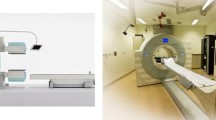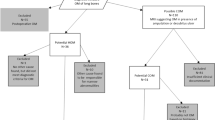Summary
In acute osteomyelitis of childhood a rapid diagnosis and initiation of antibiotic therapy is necessary in order to prevent late sequelae. Thus, diagnostic imaging plays a crucial role. If acute osteomyelitis is suspected in a child, imaging starts with conventional radiography in order to exclude other differential diagnoses. This is followed by sonography for the purpose of diagnosing a subperiosteal abscess or joint fluid from which the causative organism could be isolated. If the diagnosis is unclear, the next step should be either MRI or 99m Tc-MDP bone scan, depending on the possibility of clinical localization and the site of the suspected lesion. MRI is superior to bone scan in depicting the exact anatomy, which is extremely important in spinal osteomyelitis and preoperatively. The bone scan can show the whole skeleton in one examination and should be favored if there is no definite localization or in suspected multifocal osteomyelitis. Rarely scintigraphy with labeled white blood cells is indicated. The 67 Ga scan, however, should not be used in children because of the high level of radiation exposure. The different imaging modalities are described in detail and an imaging diagnostic workup is outlined.
Zusammenfassung
Da bei akuter Osteomyelitis im Kindesalter ein früher Behandlungsbeginn zur Vermeidung von Spätschäden wichtig ist, muß die Diagnose so rasch wie möglich gestellt werden, wobei den bildgebenden Verfahren eine wesentliche Rolle zukommt. Eine sinnvolle Bildgebung bei klinischem Verdacht auf akute Osteomyelitis im Kindesalter beginnt mit dem Röntgenbild zum Ausschluß anderer Differentialdiagnosen und der Sonographie zum evtl. Nachweis punktierbarer subperiostaler Abszesse oder Gelenkergüsse, aus denen der Erregernachweis unmittelbar möglich wäre. Falls mit Röntgenbild und Sonographie kein pathologischer Befund zu erheben ist, sollte je nach klinischer Lokalisierbarkeit des Befundes und nach Lokalisation des vermuteten Entzündungsherdes eine Magnetresonanztomographie oder ein Szintigramm angeschlossen werden. Erstere hat Vorteile in der exakten anatomischen Darstellung und ist daher auch präoperativ wichtig, letzterem ist wegen der möglichen Beurteilbarkeit des gesamten Skelettes der Vorzug zu geben bei unklarem Lokalbefund oder bei multilokulären Prozessen. In seltenen Fällen kommt die Leukozytenszintigraphie zum Einsatz. Die Galliumszintigraphie hingegen sollte im Kindesalter wegen der höheren Strahlenbelastung möglichst vermieden werden. Die einzelnen Untersuchungsverfahren werden im Folgenden dargestellt und kritisch einander gegenübergestellt.
Similar content being viewed by others
Author information
Authors and Affiliations
Rights and permissions
About this article
Cite this article
Zieger, B., Elser, H. & Tröger, J. Imaging in osteomyelitis in the growing skeleton. Orthopäde 26, 820–829 (1997). https://doi.org/10.1007/PL00003331
Published:
Issue Date:
DOI: https://doi.org/10.1007/PL00003331




